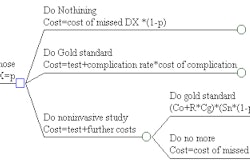Uterine artery embolization (UAE) has become increasingly popular as an alternative to hysterectomy for uterine fibroids, especially for pre-menopausal women. In contrast with hysterectomy or myomectomy, UAE -- also known as uterine fibroid embolization (UFE) -- does not require open surgery or general anesthesia, so the risk to the patient is considerably less. A paper presented at the 2002 RSNA meeting in Chicago highlighted another advantage of UAE: It’s a more cost-effective treatment for uterine fibroids than hysterectomy.
Molly Beinfeld, a researcher at the Institute of Technology Assessment in the department of radiology at Massachusetts General Hospital in Boston outlined the results of cost-analysis studies conducted by a research team at the institution.
"In our model we followed 40-year-old women with symptomatic uterine fibroids until menopause. Because the effect of UAE on fertility is unknown, the results of the study should only be applied to women with no desire for future pregnancy," Beinfeld said.
The costs and effectiveness of UAE and hysterectomy were compared by the researchers using a decision model, and an analysis was performed, including all costs and effects, regardless of who incurred them. Procedure costs used in the model were derived from Medicare reimbursement data for hospital costs and physician fees in the U.S.
"In addition to procedure costs, follow-up visits and imaging, lost wages during recovery, additional procedures, and complication costs were included in the model. Estimates for the effectiveness of the procedures, including such parameters as procedural mortality, complications, and cure rates, were taken from the literature and expert opinion," Beinfeld said.
In their base-case analysis of 60,000 patients, the team found that UAE was less expensive, at a cost of $6,715 versus $7,895 for a hysterectomy. The procedure also was more effective in terms of quality-of-life years, 8.45 for UAE versus 8.18 for hysterectomy. Beinfeld explained that this was due to the difference in recovery time between the two procedures.
UAE scores points with a shorter recovery period, according to Beinfeld. The recovery time after a hysterectomy is six weeks on average; the recovery time varies from one to two weeks for UAE.
While the overall results for UAE’s cost-effectiveness were promising, an analysis of UAE costs at Beinfield’s own institution produced markedly different results: They found that UAE procedure cost was higher than the hysterectomy procedure cost at their institution, $8,223 versus $6,046, respectively. However, the length of stay was significantly shorter -- less than 1 day for a UAE, while a hysterectomy averaged 2.6 days.
A total of 357 (300 hysterectomy, 57 UAE) patients were identified retrospectively using the hospital’s accounting system. Data on patient demographics, length of stay, and costs were derived from the system, as well as relative value units (RVUs) that reflected the technical difficulty or time costs in addition to capital and operating expenses.
The group also reviewed covariates such as the dominant fibroid size, dominant fibroid location, number of fibroids observed, and complications. They then performed linear regression analyses to determine which covariates were predictive of hospital costs for either procedure.
In addition, their research found that UAE patients were 4 years younger, on average, than hysterectomy patients but had a larger mean dominant fibroid size, 8 cm vs. 6.3 cm, as well as a higher number of fibroids.
"UAE may even be cost-saving compared to hysterectomy from a societal perspective because of the substantial savings in patient recovery time costs," Beinfeld said.
Recent analysis by other researchers has supported the cost effectiveness of UAE. Dr. Togas Tulandi and colleagues from McGill University in Montreal analyzed data from 545 women with uterine fibroids who underwent abdominal myomectomy, abdominal hysterectomy, vaginal hysterectomy, or UAE between April 1997 and October 2001.
UAE was associated with the shortest hospital stay, followed by vaginal hysterectomy, myomectomy, and abdominal hysterectomy. The total inpatient cost of UAE was approximately $1,000 Canadian ($652 U.S.) significantly less than the next least costly procedure, vaginal hysterectomy, at just over $1,500 Canadian ($978 U.S.) (American Journal of Obstetrics and Gynecology, November 2002, Vol. 187:5, pp.1401-1404).
Low cost or no, women will most likely continue to seek out UAE as an alternative to hysterectomy.
In a study published earlier this month, Gaylene Pron, Ph.D. and colleagues at the department of public health sciences, University of Toronto, in Ontario, Canada, examined the effectiveness of UAE in 555 patients. According to their results, the patients reported a 91% satisfaction rate. In addition, there was a high degree of symptom improvement (83%) and a major complication rate of less than 2% (Fertility and Sterility, January 2003, Vol.79:1, pp.120-127).
"Despite experiencing severe symptoms that had a heavy impact on their lives, women with uterine fibroids continued to seek alternatives to hysterectomy over extended periods of time," Pron wrote. "In general, women would prefer to have a benign disease such as uterine fibroids treated as conservatively as possible. Uterine fibroid embolization is giving women a nonsurgical choice that preserves their uterus."
By Jonathan S. BatchelorAuntMinnie.com staff writer
January 17, 2003
Related Reading
Embolization method less costly than surgery for uterine fibroids, December 1, 2002
Pregnancy complication rates increased after uterine artery embolization, November 1, 2002
MRI-guided cryotherapy shows promise as uterine fibroid treatment, July 3, 2002
UFE proves feasible in postmenopausal women, May 13, 2002
UAE fights fibroids, paves way for pregnancy, April 9, 2002
Copyright © 2003 AuntMinnie.com



















